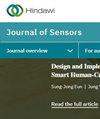通过融合局部和全局特征从遥感图像中提取建筑物的深度学习方法
IF 1.1
4区 工程技术
Q3 ENGINEERING, ELECTRICAL & ELECTRONIC
引用次数: 0
摘要
建筑物作为重要的承灾体,是地震灾害风险评估和应急救援的重点关注对象。从高分辨率遥感图像中快速、准确地提取纹理复杂、尺度和形状多变的建筑物具有重要的现实意义。我们提出了一种基于多尺度分组卷积和注意力的改进 TransUnet 模型,命名为 MATUnet,以保留更多局部细节特征,增强全局特征的表示能力,同时降低网络参数。我们设计了带有注意力的多尺度分组卷积特征提取模块(GAM),以增强对细节特征的表示。增加了卷积位置编码模块(PEG)来重新确定变换器的数量,解决了局部特征信息丢失和网络收敛困难的问题。解码器的通道注意模块(CAM)增强了特征的突出信息,解决了特征融合后的信息冗余问题。我们通过 MATUnet 在 WHU 建筑数据集和 Massachusts 数据集上进行了实验。在相同条件下,MATUnet 分别取得了 92.14% 和 83.22% 的最佳 IOU 结果,优于其他通用网络和最先进网络。我们还在 GF2 西昌建筑数据集上取得了良好的分割结果。本文章由计算机程序翻译,如有差异,请以英文原文为准。
A Deep Learning Method for Building Extraction from Remote Sensing Images by Fuzing Local and Global Features
As important disaster-bearing bodies, buildings are the focus of attention in seismic disaster risk assessment and emergency rescue. It is of great practical significance to extract buildings quickly and accurately with complex textures and variable scales and shapes from high-resolution remote sensing images. We proposed an improved TransUnet model based on multiscale grouped convolution and attention named MATUnet to retain more local detail features and enhance the representation ability of global features, while reducing the network parameters. We designed the multiscale grouped convolutional feature extraction module with attention (GAM) to enhance the representation of detailed features. The convolutional positional encoding module (PEG) was added to redetermine the number of transformer, it solved the problem of local feature information loss and the difficulty of convergence of the network. The channel attention module (CAM) of the decoder enhanced the salient information of the features and solved the problem of information redundancy after feature fusion. We experimented through MATUnet on the WHU building dataset and Massachusetts dataset. MATUnet achieved the best IOU results of 92.14% and 83.22%, respectively, and achieved better than the other generalized and state-of-the-art networks under the same conditions. We also have achieved good segmentation results on the GF2 Xichang building dataset.
求助全文
通过发布文献求助,成功后即可免费获取论文全文。
去求助
来源期刊

Journal of Sensors
ENGINEERING, ELECTRICAL & ELECTRONIC-INSTRUMENTS & INSTRUMENTATION
CiteScore
4.10
自引率
5.30%
发文量
833
审稿时长
18 weeks
期刊介绍:
Journal of Sensors publishes papers related to all aspects of sensors, from their theory and design, to the applications of complete sensing devices. All classes of sensor are covered, including acoustic, biological, chemical, electronic, electromagnetic (including optical), mechanical, proximity, and thermal. Submissions relating to wearable, implantable, and remote sensing devices are encouraged.
Envisaged applications include, but are not limited to:
-Medical, healthcare, and lifestyle monitoring
-Environmental and atmospheric monitoring
-Sensing for engineering, manufacturing and processing industries
-Transportation, navigation, and geolocation
-Vision, perception, and sensing for robots and UAVs
The journal welcomes articles that, as well as the sensor technology itself, consider the practical aspects of modern sensor implementation, such as networking, communications, signal processing, and data management.
As well as original research, the Journal of Sensors also publishes focused review articles that examine the state of the art, identify emerging trends, and suggest future directions for developing fields.
 求助内容:
求助内容: 应助结果提醒方式:
应助结果提醒方式:


